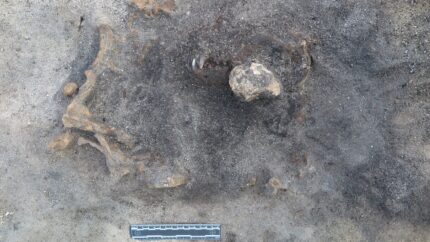The remains of a dog buried 8,400 years ago have been discovered in the Stone Age settlement at Ljungaviken, Sölvesborg. Objects found with it are believed to be grave goods, suggesting the dog was a beloved companion and colleague. It is one of the oldest dog finds ever made in Sweden, and the only one found in the middle of a Neolithic settlement.
The bones have been examined by an animal osteologist, but he was unable to identify its breed as there is no modern dog directly comparable. The closest he could get was to say that it was “like a powerful greyhound.”
“We hope to be able to lift the whole dog up in preparations, ie with soil and everything, and continue the investigations at Blekinge Museum’s object magazine.” says project manager Carl Persson at Blekinge museum.
“A find like this makes you feel even closer to the people who lived here,” he continues. “A buried dog somehow shows how similar we are over the millennia – the same feelings of loss and loss.”
When the settlement was inhabited (around 6,700-5,700 B.C.), the site was beachfront property on a small island or peninsula. The site was probably used only part of the year, in the summer and autumn, prime seasons for fishing and seal hunting. Paleobotanical finds indicate wild plants like melons and raspberries were foraged for food. Rising sea levels flooded the beach, covering the settlement with layers of wet sand and preserving it in good condition for thousands of years.
Archaeological surveys in 2015 discovered evidence of 56 different structures — hearths, postholes, pits — from the Stone Age and later materials from the Bronze and Iron Ages. The dog was buried among the Stone Age remains.
